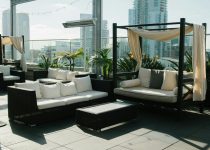Can Backyard Retractable Glass Walls Withstand Extreme Temperature Changes?
Yes, backyard retractable glass walls can withstand extreme temperature changes when built with energy-efficient features. Look for options like double or triple glazing, which enhances insulation and reduces heat transfer. Durable framing materials, especially those with thermal breaks, help maintain structural integrity in fluctuating weather. Additionally, low-emissivity coatings further optimize indoor comfort year-round. Curious about which specific features to consider for your project? There's more to discover on enhancing performance and style.
Table of Contents
Key Takeaways
- Durable aluminum frames with thermal breaks enhance energy efficiency and withstand extreme temperature fluctuations.
- Triple-glazed systems provide superior thermal performance, ideal for harsh climates.
- Low-emissivity coatings minimize heat gain in summer and retain warmth in winter.
- Argon gas-filled insulated glass reduces thermal conductivity, ensuring year-round comfort.
- Advanced design options allow for larger glass panels without compromising performance or durability.
The Importance of Energy Efficiency in Glass Walls
When you consider installing retractable glass walls, energy efficiency should be a top priority. Opting for double glazed options can significantly enhance thermal performance, making your space comfortable year-round.
Systems like NanaWall feature U-Values as low as 0.20, perfect for colder climates. By incorporating argon gas between glass panes, you'll reduce heat transfer, as argon has 67% lower thermal conductivity than air.
Low-Emissivity coatings reflect heat back indoors in winter while blocking excess heat in summer, maximizing energy efficiency. Additionally, choosing frame materials with thermal breaks helps minimize heat loss, ensuring stable indoor temperatures regardless of extreme weather.
Ultimately, these features create a seamless blend of indoor/outdoor living while keeping energy costs manageable.
Advanced Glazing Options for Temperature Regulation
To achieve optimal temperature regulation in your home, consider advanced glazing options for your retractable glass walls.
Triple-glazed systems provide superior thermal performance, especially in regions facing extreme temperature fluctuations, with U-Values as low as 0.20 for enhanced energy efficiency.
Incorporating insulated glass filled with argon gas significantly reduces thermal conductivity, leading to improved energy savings.
Additionally, low-emissivity (Low-E) coatings reflect heat back indoors during winter while minimizing heat gain in summer, ensuring year-round comfort.
Pairing these advanced glazing options with thermally broken aluminum frames helps maintain structural integrity and energy efficiency, even under severe weather conditions.
Durable Framing Materials for Extreme Conditions
Choosing durable framing materials is crucial for retractable glass walls, especially in extreme weather conditions.
Aluminum frames are engineered with thermal breaks to enhance energy efficiency and withstand extreme temperatures, making them perfect for severe climates.
NanaWall products feature aluminum clad options that combine the natural insulation of wood with the resilience of aluminum, ensuring robust weather performance.
The quadruple laminated wood frame in some systems provides added strength and stability, enduring significant temperature changes without compromising integrity.
Additionally, hybrid construction techniques enhance both durability and design flexibility, allowing these glass walls to adapt to various applications.
Properly engineered systems, including Zero Post designs, maintain stability and performance, ensuring longevity and reliability in challenging environments.
Understanding Thermal Breaks and Their Benefits
Durable framing materials play a vital role in the performance of retractable glass walls, especially in harsh climates. One key feature is thermal breaks, which serve as insulating barriers that enhance energy efficiency in extreme temperatures.
Here are three main benefits:
- Minimized Heat Transfer: Thermal breaks reduce heat transfer, allowing you to maintain comfortable indoor temperatures regardless of the weather outside.
- Improved U-Values: With U-Values as low as 0.20, these walls are ideal for areas with significant temperature fluctuations.
- Enhanced Durability: Properly designed thermal breaks prevent structural damage and warping, ensuring the longevity of your frames.
This incorporation of thermal breaks also provides flexible design options, accommodating larger glass panels without compromising performance.
Maintaining Comfort Year-Round With Retractable Glass Walls
While you might think of retractable glass walls primarily as a stylish addition to your home, they're also designed to keep your living space comfortable year-round.
With energy-efficient designs featuring double or triple glazing, these walls significantly reduce heat transfer during extreme temperature changes. Thermal breaks enhance insulation, ensuring a cozy environment no matter the weather.
Low-E coatings reflect heat back inside during winter while blocking excessive heat in summer, further maintaining comfort. Additionally, air or argon gas filling between panes boosts thermal performance, making these systems ideal for hot summers and cold winters.
High-performance weather-resistant thresholds ensure proper installation, enhancing usability and contributing to a seamless indoor/outdoor experience all year long.
Frequently Asked Questions
Can Glass Walls Be Insulated?
Yes, you can insulate glass walls effectively. Using double or triple glazing, Low-E coatings, and argon-filled units enhances thermal performance, ensuring your space remains comfortable while reducing energy costs and minimizing heat transfer.
How Much Does a Moving Glass Wall System Cost?
A moving glass wall system typically costs between $15,000 and $50,000, depending on size, materials, and installation. Custom features and energy-efficient options can also impact the overall price, so plan your budget accordingly.
What Are the Full Glass Walls Called?
You'll often hear full glass walls referred to as retractable glass wall systems. These innovative designs include sliding, folding, or stacking configurations, creating seamless transitions between your indoor and outdoor spaces while enhancing your living environment.
Are Glass Walls Energy-Efficient?
Yes, glass walls can be energy-efficient. You'll find options like double and triple glazing, along with Low-E coatings, significantly improve insulation, helping you maintain comfortable indoor temperatures while reducing energy bills year-round.



